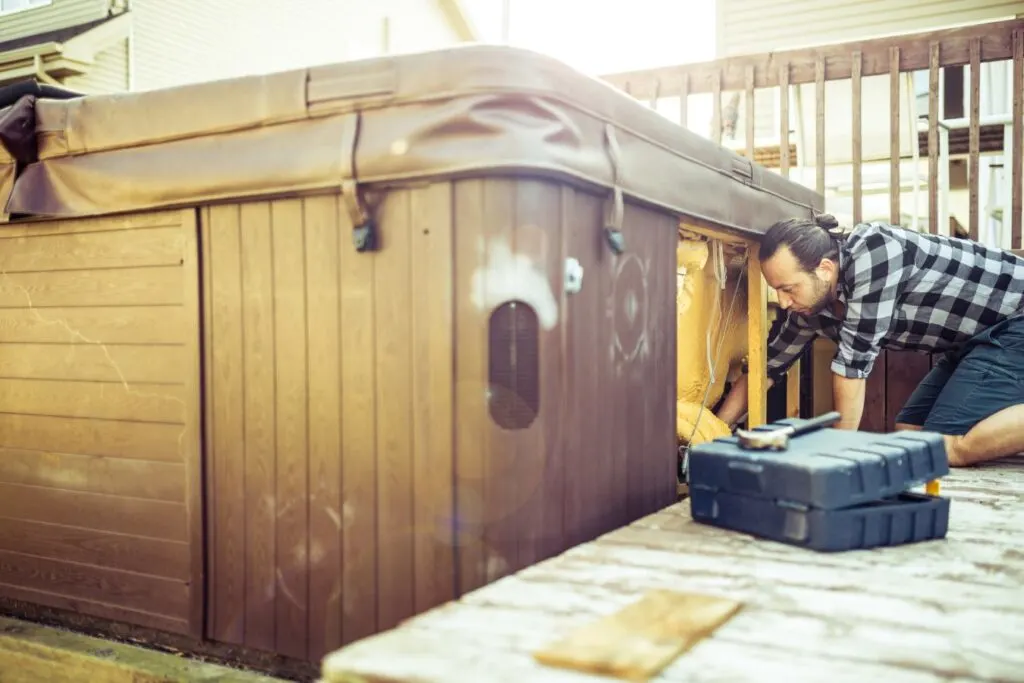Hot tubs are synonymous with relaxation, but leaks can be a major disruption. They can stem from various factors, potentially leading to costly repairs if left unattended.
In this guide, we’ll provide straightforward steps for identifying and repairing common leaks in your hot tub. These DIY repair solutions can save you time and money, restoring serenity so you can once again enjoy a leak-free experience.
Minor, DIY Hot Tub Leak Repairs

Spa Shell Leaks
Try these steps to repair your spa shell leak:
- Clean the area around the leak thoroughly.
- Use a two-part epoxy specifically designed for hot tubs to patch the crack.
- Follow the manufacturer’s instructions for the epoxy.
- Allow the epoxy to cure for the recommended time before refilling the tub.
Spa Plumbing Leaks
Try these steps to repair your spa plumbing leak:
- Tighten loose fittings or connections.
- Replace any damaged or deteriorated pipes or hoses.
- Use PVC glue or pipe tape to seal leaks in plumbing connections.
- Check the pump and filter for leaks and replace gaskets or o-rings as needed.
Jet Leaks
Try these steps to repair your jet leak:
- Remove the jet by unscrewing it.
- Inspect the gasket or o-ring around the jet.
- Replace damaged gaskets or o-rings with new ones and reseal the jet, ensuring that the new gasket provides an effective seal.
Equipment Compartment Leaks
Try these steps to repair your equipment compartment leak:
- Inspect the equipment compartment for leaks.
- Check the heater element, pressure switch, and other components for signs of water.
- Replace any faulty components.
Common Causes of Hot Tub Leaks
Hot tub and spa leaks can result from various factors. Identifying the cause of the leak is crucial before attempting a repair. Here are some of the most common causes of spa leaks:
- Damaged Shell: Cracks or punctures in the hot tub shell are a frequent cause of leaks.
- Loose Connections: Loose plumbing connections can develop due to vibration or movement of the hot tub.
- Damaged Jets: Leaks can occur if the seals around the jets are damaged.
- Worn Gaskets: Gaskets and seals, especially around the pump and heater, can wear out over time.
- Cracked Pipes: Freezing temperatures or damage can lead to cracked pipes in the plumbing.
- Faulty Pump: A leaking hot tub pump can disrupt water circulation in the hot tub, potentially causing water to leak.
Signs of a Hot Tub Leak
Hot tub leaks can be difficult to detect, but there are a few signs that can indicate a leak. Here are some common signs of a leak:
- Water Loss: If you regularly top up your hot tub water, it’s likely leaking. While some evaporation is normal, frequent refilling suggests a leak.
- Water Quality Changes: A leak can alter your water’s chemistry, causing cloudiness, wet foam, or unusual odors.
- Visible Damage: Check for visible damage, like cracks or holes in the shell or plumbing. Such damage often indicates a leak.
- Increased Bills: A leaking hot tub may require more energy to maintain the desired temperature, leading to higher energy bills.
- Mold or Mildew: The moisture from a leak can foster mold or mildew growth around your hot tub.
Tips To Find the Source of a Hot Tub Leak

If your spa’s water level has dropped, indicating a possible leak, you’ll need to locate the source promptly. Here are methods to help find the leak:
- Drain the Hot Tub: Turn off the power to your hot tub and empty it, providing a dry working area.
- Visual Inspection: Examine your hot tub’s inside and outside meticulously. Look for visible cracks, holes, or damage in the shell, as well as loose or disconnected plumbing connections.
- Water Level Test: Fill the hot tub to its usual water level and mark it with tape. After 24 hours, check the water level. A significant drop beyond normal evaporation suggests a leak.
- Dye Test: To locate hard-to-find leaks, introduce a few drops of food coloring into the hot tub water and allow it to circulate. Then, inspect the area around the hot tub for any colored water, indicating the leak’s location. Pay close attention to pump and heater connections, which are common sources of leaks.
- Check for Wet Spots: Examine the ground or deck around the hot tub for wet spots. Wet areas may indicate potential leaks.
- Inspect the Pump and Heater: Inspect the pump and heater for any signs of corrosion or rust, as these components are prone to damage and leaks.
- Listen for Unusual Noises: Leaking hot tubs may produce hissing or gurgling sounds caused by air being drawn into the plumbing through the leak. Be attentive to these noises as they can be a clue to the leak’s location.
Tools and Materials Needed
When it comes to fixing a spa leak, having the right tools and materials is essential. Here are some of the things that will be needed:
Tools
- Water pump pliers.
- Screwdriver.
- Tubing cutter.
- Hacksaw.
- Spackle knife.
- Flashlight.
- Heat gun.
Materials
- Leak-stopper liquid.
- PVC pipe or hose.
- Various new gaskets.
- O-rings.
- Spray foam insulation.
- Spa fittings and couplings.
When To Call a Professional
While some hot tub leaks can be fixed with DIY methods, sometimes it’s best to call a professional. Here are some situations where it’s recommended to seek the help of a professional hot tub repair technician:
- Major leaks: If the hot tub is leaking a significant amount of water, it’s best to call a professional. Major leaks can indicate a serious problem that requires expert attention.
- Electrical issues: If the hot tub is experiencing electrical issues, such as tripping the circuit breaker or not turning on at all, it’s best to call a professional. Electrical issues can be dangerous and should only be handled by someone with the proper training and experience.
- Complicated repairs: If the hot tub requires complicated repairs, such as replacing the heater or pump, it’s best to call a professional. These repairs can be complex and require specialized knowledge and tools.
- Warranty coverage: If the hot tub is still under warranty, it’s best to call a professional. Attempting to fix the hot tub yourself may void the warranty, so it’s important to follow the manufacturer’s guidelines and seek professional help if necessary.
FAQs
What Are Some Effective Spa Leak Sealers?
There are several spa leak sealers available in the market, including liquid sealers, epoxy putty, and silicone sealants. Liquid sealers are the easiest to use and can be poured directly into the water.
Epoxy putty can be used to patch up leaks in the plumbing, while silicone sealant is ideal for sealing small cracks and gaps.
What Is the Best Spa Leak Sealer?
The best hot tub and spa leak sealer depends on the type of water flow, leak, and the severity of the damage. Some popular shaft seal options include Flex Seal, Leak Seal, and Plast-aid.
Is It Worth Fixing a Leaky Hot Tub?
Yes, it is worth fixing a leaky hot tub as soon as possible. Ignoring a small leak can lead to further damage and more costly repairs in the future.
What Should I Do if I Can’t Locate the Source of a Spa Leak?
If the source of the leak cannot be located, it may be best to call a professional hot tub repair technician. They have specialized tools and experience to locate and fix leaks.
Are There Any Instructional Videos for Fixing a Hot Tub Leak?
Yes, there are many instructional videos available online that provide step-by-step guidance on how to fix a spa leak. Some popular channels include This Old House, Swim University, and Hot Tub University.
Can DIY Repairs Void My Hot Tub’s Warranty?
It is important to check the manufacturer’s warranty before using replacement parts or attempting any DIY repairs. Some warranties may be voided if a certified technician does not make repairs.
The Last Splash
Fixing a leak can be manageable with the right tools and knowledge. Start by visually identifying the leak’s source. For minor water leaks only, you can use products like Marlig Fix-a-Leak from Amazon.
Larger leaks may necessitate replacing damaged PVC pipes or gaskets. Remember, each hot tub is unique, so consult the manufacturer’s instructions or seek professional help when in doubt.

For over 15 years, Sean Moore has been sharing his love and enthusiasm for swimming pools and hot tubs with everyone he knows. His goal is to help everyday people DIY their maintenance to save money by teaching how to properly take care of your equipment, safely and correctly balance chemicals, and extend the life of your water oasis.

